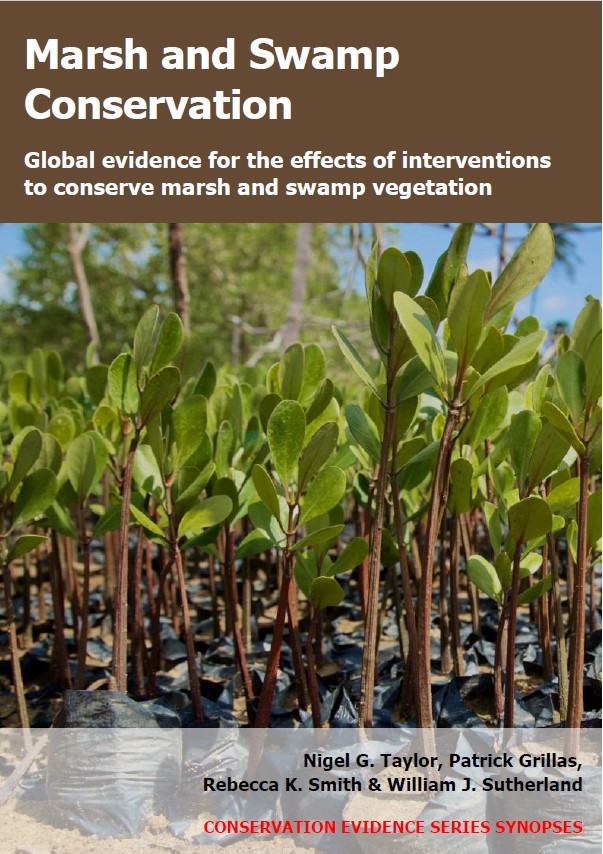Change season/timing of livestock grazing: freshwater marshes
-
Overall effectiveness category Likely to be beneficial
-
Number of studies: 3
View assessment score
Hide assessment score
How is the evidence assessed?
-
Effectiveness
50% -
Certainty
42% -
Harms
0%
Study locations
Supporting evidence from individual studies
A replicated, randomized, paired, controlled study in 2000–2003 of ephemeral pools in a grassland in California, USA (Marty 2005) found that dry season and wet season grazing had similar effects on relative cover of grasses and native plants, and on native plant richness. In three of three years, pools had similar cover of grasses relative to forbs regardless of the grazing season (dry-season-grazed: grass cover 46–55% of forb cover; wet-season-grazed: grass cover 48–54% of forb cover) and had similar cover of native plants relative to non-natives (data not reported). Over three years, pools experienced statistically similar changes in native plant richness regardless of the grazing season (dry-season-grazed: 0.5–1.0 more species/0.25 m2; wet-season-grazed: 0.6 fewer to 1.2 more species/0.25 m2). Methods: In 2000, six pairs of plots were established on a ranch grazed October–June for >100 years. Between 2000 and 2003, one plot/pair was grazed in the dry season (October–November and April–June) and one plot/pair was grazed in the wet season (December–April). All plots were grazed by 1 cow-calf pair/2.4 ha. Cattle access was controlled by electric fences. Each spring between 2001 and 2003, vegetation was surveyed in three pools/plot and in adjacent upland. Pools were 70–1,130 m2 and dry when surveyed.
Study and other actions testedA replicated, randomized, paired, controlled, before-and-after study in 1998–1999 in six fields containing a range of freshwater marsh and wet meadow habitats in Idaho, USA (Austin et al. 2007) found that summer and autumn grazing typically had similar effects on plant communities and on vegetation biomass. Over one year including a period of grazing, summer- and autumn-grazed plots experienced similar changes plant community composition (if any) in all four freshwater habitat types (data presented as graphical analyses; statistical significance of differences not assessed). In three of four freshwater habitat types, summer- and autumn-grazed plots experienced similar changes in live above-ground biomass (summer-grazed: decrease of 290 g/m2 to increase of 60 g/m2; autumn-grazed: decrease, but not always significant, of 5–140 g/m2). For the other vegetation type, plant biomass declined in summer-grazed plots (by 350 g/m2) but did not change in autumn-grazed plots (non-significant increase of 20 g/m2). Methods: The study used three pairs of fields around a lake. Each field contained a range of freshwater habitats, from permanently flooded marshes to ephemeral wet meadows. All fields had been historically grazed and cut, but were undisturbed from 1996. In each pair, one random field was grazed July–August 1998 and the other was grazed September–October 1998 (both by cattle, at 2.3–2.5 animal unit months/ha; one AUM is the amount of feed required to sustain a 1,000-lb cow and her calf for one month). Vegetation was surveyed in June–July before (1998) and after (1999) one season of grazing.
Study and other actions testedA replicated, site comparison study in 2008 of 13 ephemeral prairie pothole marshes in two pastures in Alberta, Canada (Silver & Vamosi 2012) found that summer/autumn-grazed marshes contained more wetland plant genera, and taller vegetation, than spring/summer-grazed marshes. The average number of wetland plant genera was significantly greater in the summer/autumn-grazed than the spring/summer-grazed marshes (data not reported). Three genera were only ever found in summer/autumn-grazed marshes: pondweeds Potamogeton spp., sedges Carex spp. and buttercups Caltha spp. Emergent vegetation was also significantly taller, on average, in summer/autumn-grazed (59 cm) than spring/summer-grazed marshes (32 cm). Methods: In July 2008, vegetation was surveyed in 13 ephemeral marshes: seven in one pasture grazed May–June and six in one adjacent pasture grazed August–October. Both pastures had been grazed by cattle (density not reported) under these regimes since 1994. All plant genera were identified in each marsh. For emergents, five random plants/genus/marsh were measured.
Study and other actions tested
Where has this evidence come from?
List of journals searched by synopsis
All the journals searched for all synopses
This Action forms part of the Action Synopsis:
Marsh and Swamp Conservation
Marsh and Swamp Conservation - Published 2021
Marsh and Swamp Synopsis





)_2023.JPG)














